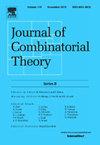The structure of quasi-transitive graphs avoiding a minor with applications to the domino problem
Abstract
An infinite graph is quasi-transitive if its vertex set has finitely many orbits under the action of its automorphism group. In this paper we obtain a structure theorem for locally finite quasi-transitive graphs avoiding a minor, which is reminiscent of the Robertson-Seymour Graph Minor Structure Theorem. We prove that every locally finite quasi-transitive graph G avoiding a minor has a tree-decomposition whose torsos are finite or planar; moreover the tree-decomposition is canonical, i.e. invariant under the action of the automorphism group of G. As applications of this result, we prove the following.
- •
Every locally finite quasi-transitive graph attains its Hadwiger number, that is, if such a graph contains arbitrarily large clique minors, then it contains an infinite clique minor. This extends a result of Thomassen (1992) [38] who proved it in the (quasi-)4-connected case and suggested that this assumption could be omitted. In particular, this shows that a Cayley graph excludes a finite minor if and only if it avoids the countable clique as a minor.
- •
Locally finite quasi-transitive graphs avoiding a minor are accessible (in the sense of Thomassen and Woess), which extends known results on planar graphs to any proper minor-closed family.
- •
Minor-excluded finitely generated groups are accessible (in the group-theoretic sense) and finitely presented, which extends classical results on planar groups.
- •
The domino problem is decidable in a minor-excluded finitely generated group if and only if the group is virtually free, which proves the minor-excluded case of a conjecture of Ballier and Stein (2018) [7].

 求助内容:
求助内容: 应助结果提醒方式:
应助结果提醒方式:


